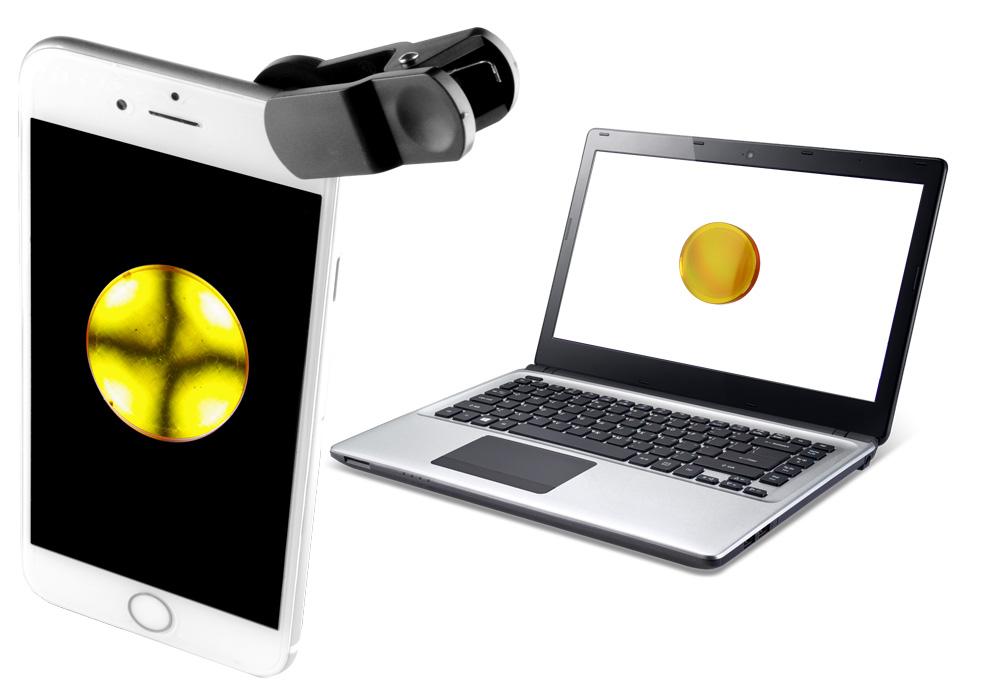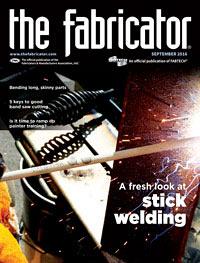Senior Editor
- FMA
- The Fabricator
- FABTECH
- Canadian Metalworking
Categories
- Additive Manufacturing
- Aluminum Welding
- Arc Welding
- Assembly and Joining
- Automation and Robotics
- Bending and Forming
- Consumables
- Cutting and Weld Prep
- Electric Vehicles
- En Español
- Finishing
- Hydroforming
- Laser Cutting
- Laser Welding
- Machining
- Manufacturing Software
- Materials Handling
- Metals/Materials
- Oxyfuel Cutting
- Plasma Cutting
- Power Tools
- Punching and Other Holemaking
- Roll Forming
- Safety
- Sawing
- Shearing
- Shop Management
- Testing and Measuring
- Tube and Pipe Fabrication
- Tube and Pipe Production
- Waterjet Cutting
Industry Directory
Webcasts
Podcasts
FAB 40
Advertise
Subscribe
Account Login
Search
Is this laser cutting lens damaged?
A new diagnostic tool, clipped to a smartphone, reveals how stressed a laser optic really is
- By Tim Heston
- September 16, 2016
- Article
- Laser Cutting

This crossed polarizer works with a smartphone’s polarized flat-panel display to reveal imperfections in laser optics.
An operator notices part edge quality degrading on certain pieces cut by the CO2 laser. Something’s amiss. The department lead or maintenance tech comes over to troubleshoot. It’s probably the lens. The tech inspects the lens, sees nothing, but replaces it anyway, just in case. The laser fires up, and, alas, the cutting problem persists.
This is a classic case of not having the right tools for the job, like a crossed polarizer that allows a technician to inspect the lens and plainly see the imperfections, or lack thereof.
“I’d say the majority of operations do not have some type of crossed polarizer in their shop right now. That’s something we’re trying to change.”
So said Chris Smith, global aftermarket sales manager for II-VI Incorporated, Saxonburg, Pa., a company that has been selling a desktop crossed polarizer for about five years. This past summer it introduced its mini LSA, a lens stress analyzer that clips to, and works with, a smartphone’s camera and flat-panel display.
“You have internal stresses in the lenses that you cannot see with the naked eye,” Smith said. “Focusing lenses, which are common optics that need to be maintained, can be difficult to inspect. You can look at them and sometimes see if they need to be cleaned, or if they have external damage.” But detecting internal damage, he said, isn’t quite so straightforward.
As Smith explained, lens cleaning procedures vary throughout the industry. Some have a regular preventive maintenance schedule, inspecting the optics and (if needed) cleaning and polishing them at defined intervals. Even so, most resort to reactive maintenance from time to time. “Many do not have a defined [optics inspection] procedure,” Smith said. “It’s like a car—it runs great until it doesn’t. And when I see a problem, I’m opening the hood and poking around.”
Of course, “poking around” often doesn’t get to the root cause of the problem, especially if you lack the right diagnostic tools. This, Smith said, is where crossed polarizers play a role.
A polarized lens blocks certain light waves while letting others through. Wearing polarized sunglasses while fishing blocks the sunlight reflecting off the water’s surface, so you can see fish swimming underneath.
To use a traditional crossed polarizer, a tech places the laser focusing lens between two polarized plates. He then rotates the second polarized plate. As the second polarized plate is rotated, patterns start to appear. As Smith explained, the crossed polarizer works not only for CO2 optics like the focusing lens, but also for the cover glass on a fiber laser.
The resulting patterns can range from completely clear (clean lens) to a small cross pattern (lightly stressed) to a stark starburst (heavily stressed). In essence, the device shows the tech the optic’s condition, whether it’s perfectly clean, just a little dirty and so could use some cleaning or polishing, lightly stressed, or heavily stressed and nearing the point of total failure.
Excessive heat in a specific area of the optic causes thermal lensing, or a distortion of the beam as it passes through. This occurs when the optic’s absorption increases rapidly in certain areas, creating nonuniform heating that stresses the lens. This changes the focus point, which changes the cutting parameters and causes a bad part edge.
A desktop polarizer isn’t very portable, and for a laser operator or technician, that can be a hassle. This, Smith said, is where the small clip-on lens stress analyzer fills a need.
Smith added that the idea for the device came about from the fact that most modern smartphones use polarized flat-panel displays. If you wear polarized sunglasses, look at your phone and rotate it; you’ll notice the images on the screen change and, at certain angles, completely disappear. The polarization pattern in your glasses is blocking all visible light emitted from the polarized flat panel.
Crossed polarizers require two polarized plates—so why couldn’t a phone’s polarized flat panel act as the second polarized plate? Another plus: If the crossed polarizer worked with the phone, the operator could take a picture of the resulting image and send it to the maintenance tech, department supervisor, or lens vendor.
One argument against having a crossed polarizer, Smith said, is that a lens nearing catastrophic failure is pretty obvious to troubleshoot. A tech might take the lens out and see molten metal on the lens surface—a classic “absorption site” on an optic. He obviously needs to replace the lens, and he doesn’t need a diagnostic tool to tell him so.
But as Smith explained, crossed polarizers can still reveal the nature of such drastic lens failures, helping with root cause analysis. Ideally, of course, crossed polarizers should come into play to detect problems before they become catastrophic failures, which can lead to expensive repairs.
“This is another tool in the toolbox,” Smith said. “It helps troubleshoot problems. A lot of people will pull out a lens, look at it, and say there’s nothing wrong with it. Well, maybe that’s true and maybe it isn’t. But without a crossed polarizer, you won’t really know.”
About the Author

Tim Heston
2135 Point Blvd
Elgin, IL 60123
815-381-1314
Tim Heston, The Fabricator's senior editor, has covered the metal fabrication industry since 1998, starting his career at the American Welding Society's Welding Journal. Since then he has covered the full range of metal fabrication processes, from stamping, bending, and cutting to grinding and polishing. He joined The Fabricator's staff in October 2007.
Related Companies
subscribe now

The Fabricator is North America's leading magazine for the metal forming and fabricating industry. The magazine delivers the news, technical articles, and case histories that enable fabricators to do their jobs more efficiently. The Fabricator has served the industry since 1970.
start your free subscription- Stay connected from anywhere

Easily access valuable industry resources now with full access to the digital edition of The Fabricator.

Easily access valuable industry resources now with full access to the digital edition of The Welder.

Easily access valuable industry resources now with full access to the digital edition of The Tube and Pipe Journal.
- Podcasting
- Podcast:
- The Fabricator Podcast
- Published:
- 04/16/2024
- Running Time:
- 63:29
In this episode of The Fabricator Podcast, Caleb Chamberlain, co-founder and CEO of OSH Cut, discusses his company’s...
- Trending Articles
How to set a press brake backgauge manually

Capturing, recording equipment inspection data for FMEA

Tips for creating sheet metal tubes with perforations

Are two heads better than one in fiber laser cutting?

Hypertherm Associates implements Rapyuta Robotics AMRs in warehouse

- Industry Events
16th Annual Safety Conference
- April 30 - May 1, 2024
- Elgin,
Pipe and Tube Conference
- May 21 - 22, 2024
- Omaha, NE
World-Class Roll Forming Workshop
- June 5 - 6, 2024
- Louisville, KY
Advanced Laser Application Workshop
- June 25 - 27, 2024
- Novi, MI



























